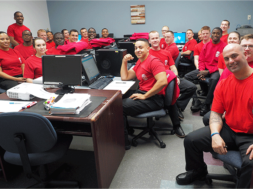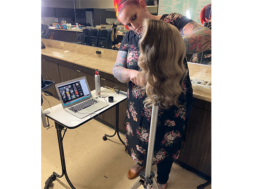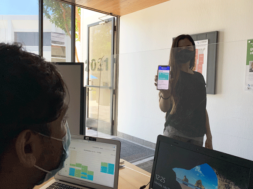
Alleviating Campus Issues…Before They Become Crisis
By Kristen Torres, Regional Director of Operations, Pima Medical Institute
Fear. It can confine us, and ironically propel us. It can push us to take action, and paradoxically prevent us from making the necessary change because the outcome waiting on the other side is just a little too…unknown. Fear drives us in many ways and yet holds us back at the same time. Have you ever delayed taking action with a student or employee because the potential chain of events following was too disruptive? You know, the kind of potential outcomes that wake you up at 3 a.m., playing scenario by scenario like a screenplay out in your mind? They make you question “Did I do the right thing? Could I have done something different? Have I kept everyone safe?”
As school operators, we manage the full gamut of behaviors, incidents, and potentially volatile threats on a daily basis. It’s tough, and that’s an understatement. Yet to say it’s rewarding if we do it well, is also an understatement. Just when we think we’ve seen it all, another situation crops up that has us declaring “I just can’t make this stuff up, it’s too far out there.” The key to handling these potentially disruptive situations on campus is to build a team fully engaged and armed with every resource available to assuage issues and prevent them altogether. When you have built a team that is capable of alleviating concerns efficiently and effectively, the disruption factor will cease and allow you and your team to remain laser-focused on successful outcomes. Handling campus issues and assembling your team can be organized into three main areas: Prevent, Prepare, and Protect.
In order to truly understand how your school can strengthen its handle on issues, I recommend first taking a step back and fully analyzing your history, exposures, and needs.
Create a Safety Advisory Committee to conduct a SWOT analysis and articulate the issues relevant to your school. The Safety Advisory Committee serves not only as a focus group but as ambassadors to carry out important safety initiatives on campus. The goal is to dissect your vulnerabilities in partnership with your campus leadership team and implement action items based on analysis. According to WorkSafeMT, a non-profit dedicated to enhancing workplace and school safety, creating a committee to promote a culture of safety is a fundamental component of a successful work/school environment. “Developing a culture of safety in your workplace not only holistically supports your employees, but it’s also proven to directly – positively – impact the company’s bottom line.”
Preferably, your committee will be comprised of a diverse mix within your organization. Depending on the size of your school, a committee of 5-15 members will provide flexibility and diversity of thought. Incorporate different levels of faculty and staff with varied backgrounds and experience, making sure there is an appointed leader. “Ideally, the committee should have representation from both management and labor, as well as from all departments and shifts,” according to WorkSafeMT (worksafemt.com). You can break your committee into smaller focus groups, even involve students in order to get your most candid feedback, as long as there is a central organizer and trusted facilitator for the group.
Identifying the types of issues will allow you to compartmentalize as well as bridge the gap. For some members who might not have much tenure within the organization, a brief synopsis to inform them of historical events, concerns, even traditions can help them understand the big picture. What types of campus situations have you encountered? What were the lessons learned? Where do your vulnerabilities still lie? What type of risks and to what level is inherent with said exposure? What time and resources do we need to devote? Which issues are urgent and require immediate action? These are critical questions the committee should debate.
Types of issues your team should be prepared to analyze:
- Personality and performance related (students, employees, employers)
- Internal and external safety concerns
- Compliance, regulatory
- Community image, media, brand
- Situations with the potential to escalate quickly
Prevent
Preventing student issues is naturally your first line of defense to avoid escalated situations altogether. Every person on campus needs to play a vital role in providing the necessary support and resources throughout the student lifecycle. Creating a robust New Student Orientation is the perfect way to get students started on the right foot. If you don’t have a comprehensive NSO, you are missing out on a key opportunity to set high expectations, inform students of their resources, and create a motivating and exciting environment for them. All key campus personnel from administrative departments should attend, each to speak briefly about their role and department.
If you don’t already have one, create an online format where they can log in through a student portal and access the information at any time. Online acknowledgment forms will serve as records in their student portal and is a big compliance win. It is especially efficient and effective if you can bring students into a computer lab for their NSO, and walk them through the acknowledgment forms together. Review school policy forms that they can acknowledge on the spot and have an open discussion on your policies to set the right tone of expectations.
Policies to review:
- Dress code and professionalism
- Grading scale
- Attendance policy
- Professionalism performance standards
- Social media policy
- OSHA & pathogens exposure control plan
- Campus safety and security report
- Sexual violence prevention & awareness
- Academic catalog
Providing robust resources and a positive campus climate is essential in preventing the escalation of issues.
Students, faculty, and staff alike need to be engaged in morale-boosting activities in order to function at their best.
In an article titled, 10 Steps to Creating a More Secure Campus, by Dr. Neal Raisman, simple gestures such as training everyone to greet students and listen to their response are cited as having a big impact on morale, understanding the pulse of a student body, and fostering a caring culture. “Have all employees learn how to say hello, smile, and ask others how they are doing once they enter the ‘greeting zone.’ Also, teach them how to follow up on less than positive responses from others. This is important. The school must indicate that it cares about each student to increase a collective sense of comfort through caring. This is also important for other reasons-from identifying upset students, to showing you care, to learning what can be done to improve customer service and increase retention,” according to Dr. Raisman. Here are a few things to consider in creating a campus climate that cares:
- Promote an active and engaging campus life through regularly scheduled student appreciation events, faculty and staff appreciations, mentoring and student ambassador opportunities, and community service and volunteer opportunities. Consistently planning and executing these types of appreciation events and teambuilding opportunities will create excitement and a positive buzz on campus, increase confidence and feelings of value, and foster school loyalty and pride.
- Invest in a Work Study Tutoring Program where students can sign up for tutoring and receive help from their fellow students. Make announcements in classrooms and post tutoring hours up around campus. Make the process as easy as possible for students to receive assistance. This is also a terrific experience and a resume builder for your Work Study students. They are able to work and earn in a convenient location, and you are able to provide assistance to the other students at a very low cost.
- Assess your Request for Accommodations Process. Is the process clear and straightforward? Are your Admissions Representatives, Student Services, Career Services, and faculty trained on a regular basis on the process and how to delicately handle RFAs in a compliant fashion?
- Student Services personnel should receive regular training and support for counseling success. In addition to outside training opportunities, there are a lot of training resources that can be tapped into locally. Police officers, crisis teams, agencies, security companies, and even non-profits are excellent resources to invite to campus for comprehensive training. Many of them will come and deliver in services to your faculty and staff or 1:1 coaching sessions with your Student Services team, and provide their training for free or a very nominal speaker fee. They are truly the experts in violence prevention, safety awareness, substance abuse, and crisis management. If you aren’t utilizing your local experts for advice and training, please do so. By having them out on campus, it also serves an important relationship role to help you receive faster service should you ever need help in an emergency.
In all the hustle and bustle of campus life, you and your team should have an internal warning communication system to immediately notify necessary parties of student concerns. Faculty should have a clear, quick path to notify Student Services and Administration of any alerts, including not just behavioral concerns but also absences and academic challenges. A red flag process, whether an email template or form within your system, should concisely state the student and issue. An absence going more than a day should be followed with a phone call from Student Services or their teacher. Students with behavioral or academic challenges can be referred to Student Services or tutoring services, and get the direction they need. It further fosters the culture of caring and intervenes at an early stage. Often times, referring a student back to Admissions to speak with their representative is an effective strategy for discussing motivation and what may or may not have changed since they first enrolled. The key is early intervention.
Regular retention meetings are an effective strategy for coming together as a leadership team to discuss each program and review attendance, academic, or behavioral concerns. Retention roundups can help increase interdepartmental communication amongst your campus and get key players taking ownership of student success. Meeting once a week or biweekly, depending on your campus needs, your retention meetings should consist of Program Directors, Faculty Leads, Student Services, Career Services, and the Campus Director/Associate Director. Analyze classes and subjects causing retention challenges. Look at behavioral trends amongst students and pinpoint faculty development needs. It’s imperative to get into the weeds in order to get to the root of the problems!
Prepare
If you have developed your prevention strategies fully, you mitigate the frequency in which escalated issues arise. That being said, every school deals with stressful, potentially dangerous threats from time to time that require us to prepare. First and foremost, your Crisis Management Plan is the strongest, most compliant way to prepare your team for emergencies. Your CMP should encompass steps to take in an emergency: alarm warning codes, evacuation plans, lockdown procedure, and communication. Each procedure should be clearly written and published. Make sure it is in compliance with the Clery Act and with your institutional accreditor, and seek external expert advice if necessary. Local law enforcement, emergency responders, and security companies can provide valuable insight and feedback to your CMP and can assess potential considerations for your campus layout.
An Emergency Notification System like e2Campus, Everbridge, or Omnilert are critical tools to help you communicate with your entire school quickly and effectively. In a true emergency, the last thing anyone wants to do is run around and make a hundred calls/texts. These notification systems are customizable and allow you and a select trained few on campus to communicate an emergency at the touch of a button, controlled through an app on your phone or your desktop. Campus Safety Magazine discusses best practices in utilizing these systems, imploring institutions to make sure they can incorporate their emergency response protocols into their emergency notification system during the implementation process. “A good place to start is putting your institution’s notification procedures in the emergency communications system and, if possible, automating standard operating procedures.” (Zach Winn)
The more prepared and rehearsed your team is with their CMP the more they are enabled to de-escalate a crisis quickly.
Practice your CMP regularly with evacuation and lockdown drills, alternating between the two. Have planned and unplanned drills.
Give people a hint like “a drill will take place next week but the date and time will be unknown.” Provide feedback on the team’s performance during the drills. Celebrate progress! If they shaved off one minute of time for everyone to evacuate, that should be reason to celebrate. With regular rehearsals and drills, and faculty reviewing the CMP with each new class, students and employees will feel more confident, calm, and prepared in the case of an emergency. As news headlines continue to increase anxiety levels in everyone’s minds regarding safety, the more we can do to facilitate a feeling of preparedness and confidence will translate into a more secure and safe climate.
Building a dynamite De-Escalation Tribe is an important component to protecting your team when issues arise. This is not the same as your Safety Advisory Committee, which would be a larger, well-rounded mix of representatives on campus who assess and implement safety measures. Your De-Escalation Tribe are 2 or 3 of your most trusted individuals on campus who are skilled in handling situations in a time of crisis. They can artfully talk someone off the ledge and can take a stressful and potentially dangerous situation and help bring logical resolve through mediation and calm problem-solving. They are often trained counselors, emergency responders, or a faculty member who has a talent for getting through emotionally to students in difficult situations. Identify who these individuals are and let them know their importance and role. Meet with them regularly to build and empower them, providing training and development opportunities. Consider implementing a “partner approach” for difficult meetings and also involving the resources of agencies. For example, your local VA might be incredibly valuable in helping you manage a PTSD veteran.
As a school, reflect and review your campus safety measures in your all-staff meetings. Have your Safety Advisory Committee present to employees the current initiatives and progress. Hold monthly or quarterly lunch training for the team covering hot topics. Invite outside resources in such as your security company or local law enforcement. It is important to celebrate near misses as learning opportunities and openly analyze and discuss progress. Don’t forget to reward the team with fun and kudos for issues handled well!
Protect
Assessing security needs can be a difficult task. There’s a lot to weigh, including cost, what level of security, risk, and every variation of scenario to consider if you don’t have it. Some schools are perfectly fine without hired security, and other schools rely heavily on it. Only you and your team can determine what is best in protecting your campus. Things to consider when evaluating security needs:
- Campus size and census
- Number of ports of entry on and into campus
- Neighborhood and external factors
- Student demographics and particularly volatile students
- Prior history of a crisis or situation
- Internal hire or external contract
- Full/part-time, or situational needs
If you do have security, establishing frequent communication and trust with your security personnel and (if applicable) their management company is critical. Review their daily logs, have them check in with you weekly and discuss concerns or findings. You must keep a pulse on what your guards are experiencing, as well as their professionalism surrounding students. Invite them to team meetings and events, so they feel a part of the team and invested in the school.
Protecting students and employees is what keeps a lot of us up at night. Yet it is more than just physical safety that we need to consider when looking holistically at how to protect our schools. We must protect our compliance practices and be vigilant to meet regulations and standards. We must protect against risk exposures and premises liability. We must protect our brand by staying on top of media and external communications. It is imperative to create a culture of compliance in order to protect our students, employees, and schools.
In Designing Trustworthy Organizations, (Robert F. Hurley, Nicole Gillespie, Donald L. Ferrin, Graham Dietz) there are six identifying signals that employees consider when deciding to follow a company. They are:
- Common values: does the company share our beliefs and values?
- Aligned interests: does the company interests coincide, rather than conflict with ours?
- Benevolence: does the company care about our welfare?
- Competence: is the company capable of delivering on its commitments?
- Predictability and integrity: does the company abide by commonly accepted ethical standards and is the company predictable in how it behaves?
- Communication: does the company listen and engage in a dialogue or not?
These are framework questions to reflect on when aiming to establish a compliant, safe, and positive culture. Ask yourself if you and your top leadership within the organization model these behaviors, and what areas can be improved on.
There are many best practices for creating a culture of compliance. It is something that needs to be ingrained into the minds and actions of every employee. Detailed training on how to document every situation appropriately needs to be a major priority in employee development. Consistent coaching, auditing, and feedback need to be implemented. Internal and external audits are both important tools to help you uncover any possible breaches or weaknesses. You can also incorporate adherence to compliance in employee’s annual reviews. If they know they will be evaluated on compliance topics at the end of the year and can influence their overall performance evaluation, employees take note and push compliance higher up on their scale of priorities.
Teaching employees how to protect your reputation and brand is not only more difficult in light of the current climate, but more important than ever.
Publish a detailed social media policy for students and employees, and consistently review and train. Your Crisis Management Plan should include rules for who is allowed to talk to media during a crisis event. Ensure all employees know who the designated spokesperson is for your organization and minimize individuals involved in the conversation. Also, noteworthy is managing Glass Door, Yelp, and other online reviews. Respond quickly to negative comments on social media and encourage happy students and employees to write positive reviews to share their experiences. If you are an organization practicing the six identifying signals (above), you can feel confident your entire school will take pride in protecting the school.
In summary, the framework for alleviating issues can be broken down into Prevent, Prepare, and Protect:
- Identify your vulnerabilities with your team
- Formulate strong, diverse committees
- Implement consistent policies and procedures
- Build your trusted tribe
- Review and assess regularly
- Celebrate near misses as learning moments
- Create a culture of compliance
One final thought regarding the big picture. That is, to remind each other of WHY. We each have a personal story or “aha moment” as to why we do what we do. Openly share yours with your team, and know your employees’ WHY. Remind each other of it regularly because it will help carry you through the stressful days and help overcome some of the fears we are faced with each day.
While fear is a catalyst on many levels and can be used to push us, the one thing it should not do is define us. There’s a metaphor that has served me well in many coaching sessions. I’ve kept an old picture at my desk: I’m bungee jumping 600 meters from a gondola over a waterfall in the Swiss Alps. People ask, “How on earth did you get the courage to do that, being afraid of heights?” My answer is simple. There are points in life where you stand, paralyzed until you take a leap of faith. Make the jump. Push yourself from fear into freedom.
Encourage your team to turn fear on its head and not give it a voice. Recognize its drivers and discuss them openly together. Teach and model the same in your students. The fears we don’t face will end up becoming our limits.
“F-E-A-R has two meanings: ‘Forget Everything and Run’ or ‘Face Everything and Rise.’ The choice is yours.” – Zig Ziglar
KRISTEN TORRES, for the last 16 years, has driven excellence in private postsecondary education through a collaborative partnership style dedicated to student outcomes. Kristen takes pride in empowering her employees to create innovation and growth, producing award-winning programs and initiatives while enhancing company values and culture. She is currently serving as Regional Director of Operations for Pima Medical Institute, overseeing the western region of 8 campuses. Prior to her regional role, she served as Campus Director for Pima’s Mesa, AZ campus for 8 years. A Valley Leadership alumna, Kristen is a board member of the Arizona Private School Association, having served as President and Legislative Chair. Some of her most challenging and rewarding work has been educating elected political leaders regarding the benefits of our sector both at the State Capitol and in D.C. Committed to giving back, Kristen serves on several community boards and advisory councils, including Abrazo Scottsdale Hospital and the American Lung Association of Arizona. In 2015 Kristen was named a top Forty-Under-40 professional by the Phoenix Business Journal. Outside of work Kristen can be found trekking to exotic adventures with her family and searching for awesome food.
Contact Information: Kristen Torres // Regional Director of Operations // Pima Medical Institute // 480-565-6174 // ktorres@pmi.edu // Social Media: linkedin.com/in/kristenblakelytorres











